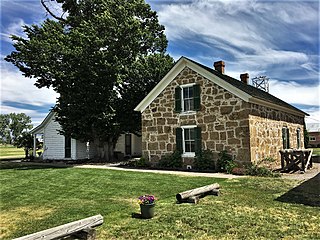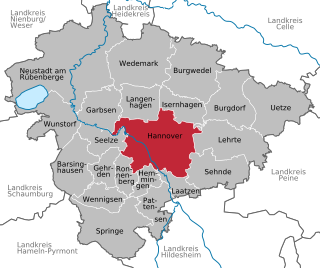
Spring Mountain Ranch State Park is a public recreation area located within the Red Rock Canyon National Conservation Area in Nevada's Cottonwood Valley, five miles (8.0 km) northwest of Blue Diamond, Nevada. The state park preserves the historic Sandstone Ranch, which was entered into the National Register of Historic Places as a historic district in 1976.

The Wallace House is a Georgian style historic house, which served as the headquarters of General George Washington during the second Middlebrook encampment (1778–79), located at 38 Washington Place, Somerville, Somerset County, New Jersey, United States. It was added to the National Register of Historic Places on December 2, 1970.

Fort Churchill State Historic Park is a state park of Nevada, US, preserving the remains of a United States Army fort and a waystation on the Pony Express and Central Overland Routes dating back to the 1860s. A 1994 addition forms a corridor along the Carson River. The park is in Lyon County south of the town of Silver Springs. Fort Churchill was designated a National Historic Landmark in 1961. The site is one end of the historic Fort Churchill and Sand Springs Toll Road. It is located on U.S. Route 95 Alternate, 8 miles (13 km) south of U.S. Route 50.

The Kyle Ranch was established by Conrad Kiel in 1875 in what is now North Las Vegas, Nevada. The ranch's name is spelled alternately as "Kiel" and "Kyle" because Conrad Kiel spelled his name and ranch both ways. The site is currently managed by the City of North Las Vegas Parks and Recreation Division as the "Kiel Ranch Historic Park." As of July 2016, the park is open to the public. The original adobe structure, one of the oldest extent buildings in Las Vegas, a wooden shed known as the "Doll House" and the Kyle Ranch Cemetery are all that remain after loss of buildings through fire and neglect.

Sandstone Ranch or Sand Stone Ranch, as it was first known, was listed on the United States National Register of Historic Places on April 2, 1976. The ranch is within the boundaries of the Spring Mountain Ranch State Park and Red Rock Canyon National Conservation Area and sits below the Wilson Range.

Herbert and Katherine Jacobs First House, commonly referred to as Jacobs I, is a single family home located at 441 Toepfer Avenue in Madison, Wisconsin, United States. Designed by noted American architect Frank Lloyd Wright, it was constructed in 1937 and is considered by most to be the first Usonian home. It was designated a National Historic Landmark in 2003. The house and several other properties by Wright were inscribed on the World Heritage List under the title "The 20th-Century Architecture of Frank Lloyd Wright" in July 2019.

Tule Springs Ranch and the remaining buildings are listed as a district on the United States National Register of Historic Places in Las Vegas, Nevada. Part of the area is included in the Tule Springs Archaeological Site and is listed on the U.S. National Register of Historic Places. The building are part of the Floyd Lamb Park at Tule Springs which is operated by the City of Las Vegas. Located about 20 miles from the Strip off U.S. Highway 95 north.

Walking Box Ranch, 7 mi (11 km) west of Searchlight, Nevada in the Mojave Desert, was founded in 1931 by Rex Bell and Clara Bow as a working 400,000 acres (160,000 ha) ranch. The ranch covered 160 acres (65 ha) at the time it was listed on the National Register of Historic Places on January 30, 2009. The ranch includes four buildings and is owned by the Bureau of Land Management (BLM).

The Nevada-California-Oregon Railroad Depot was built by the Nevada-California-Oregon Railway (NCO) in 1910 in Reno, Nevada. It is Nevada Historical Marker number 210. It is also listed in the National Register of Historic Places. The building today is used for a restaurant and microbrewery called The Depot Craft Brewery Distillery

The Nevada-California-Oregon Railway Locomotive House and Machine Shop was built by the Nevada-California-Oregon Railway in 1889 in Reno, Nevada.

The Twaddle-Pedroli Ranch, also known as the Jackson-Harp Ranch, Rand Property and the Wilson Commons Ranch, was purchased by John Twaddle in 1869 for $5,000. The ranch, several miles to the north of Franktown, Nevada and adjacent to the Bowers Mansion, was then known as the Sturtevant Ranch. The property amounted to 630 acres (250 ha).

The Dangberg Home Ranch Historic Park is a Douglas County, Nevada, USA, park, preserving one of the state's first ranches.

The historical buildings and structures of Grand Teton National Park include a variety of buildings and built remains that pre-date the establishment of Grand Teton National Park, together with facilities built by the National Park Service to serve park visitors. Many of these places and structures have been placed on the National Register of Historic Places. The pre-Park Service structures include homestead cabins from the earliest settlement of Jackson Hole, working ranches that once covered the valley floor, and dude ranches or guest ranches that catered to the tourist trade that grew up in the 1920s and 1930s, before the park was expanded to encompass nearly all of Jackson Hole. Many of these were incorporated into the park to serve as Park Service personnel housing, or were razed to restore the landscape to a natural appearance. Others continued to function as inholdings under a life estate in which their former owners could continue to use and occupy the property until their death. Other buildings, built in the mountains after the initial establishment of the park in 1929, or in the valley after the park was expanded in 1950, were built by the Park Service to serve park visitors, frequently employing the National Park Service Rustic style of design.

Manistee Ranch was founded in 1897 by Herbert W. Hamilton, a native of Wisconsin. The ranch, located in the town of Glendale, Arizona, was rich in citrus fruits and dates. The ranch has all of its historical structures restored. It is administered by the Parks and Recreation Department of Glendale.

The Walter Cliff Ranch District, at 7635 Old HW 395 in Washoe Valley, Nevada is a historic site that was listed as a historic district on the National Register of Historic Places in 1985. It has significance dating from c.1870, when the house was built. The listing included two contributing buildings: the house and a root cellar/residence building.

The Alamo Ranchhouse, near Steamboat, Nevada, is a historic "plantation style mansion" that was built in 1887. Also known as the Moffat Ranchhouse, it was listed on the National Register of Historic Places in 1979. The listing included one contributing building and one contributing structure.
Russell Mills (1892-1959) was an American architect based in Reno, Nevada. A number of his works are listed on the U.S. National Register of Historic Places. He "spent early years" in the Philippines. He worked as a draftsman for noted architect Frederic DeLongchamps.

The Jobs Peak Ranch, near Genoa, Nevada, includes a historic Swiss Chalet style main house built in 1936. It was designed by young architect Russell Mills, perhaps as his first individual major commission, and is listed on the National Register of Historic Places. It was listed on the National Register of Historic Places in 2001; the listing included three contributing buildings and two contributing structures.

The Peavine Ranch, at 11220 N. Virginia St. in Reno, Nevada, is a historic 5.2-acre (2.1 ha) property with significance dating to 1862. It was listed on the National Register of Historic Places in 2000; the listing included five contributing buildings. It was once a stagecoach stop, but became a ghost town after a fire in 1900.





















